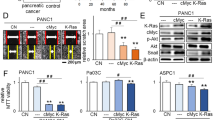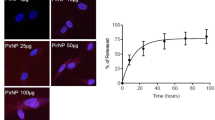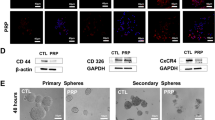Abstract
Mesenchymal stem cells (MSCs) have attracted great interest in cancer therapy owing to their tumor-oriented homing capacity and the feasibility of autologous transplantation. Currently, pancreatic cancer patients face a very poor prognosis, primarily due to the lack of therapeutic strategies with an effective degree of specificity. Anticancer gene-engineered MSCs specifically target tumor sites and can produce anticancer agents locally and constantly. This study was performed to characterize pancreas-derived MSCs and investigate the effects of tumor necrosis factor-related apoptosis-inducing ligand (TRAIL)-engineered MSCs on pancreatic cancer cells under different culture conditions. Pancreas-derived MSCs exhibited positive expression on CD44, CD73, CD95, CD105, negative on CD34 and differentiated into adipogenic and osteogenic cells. TRAIL expression was assessed by both enzyme-linked immunosorbent assay and western blot analysis. Different patterns of TRAIL receptor expression were observed on the pancreatic cancer cell lines, including PANC1, HP62, ASPC1, TRM6 and BXPC3. Cell viability was assessed using a real-time monitoring system. Pancreatic cancer cell death was proportionally related to conditioned media from MSCnsTRAIL and MSCstTRAIL. The results suggest that MSCs exhibit intrinsic inhibition of pancreatic cancer cells and that this effect can be potentiated by TRAIL-transfection on death receptor-bearing cell types.
This is a preview of subscription content, access via your institution
Access options
Subscribe to this journal
Receive 12 print issues and online access
$259.00 per year
only $21.58 per issue
Buy this article
- Purchase on Springer Link
- Instant access to full article PDF
Prices may be subject to local taxes which are calculated during checkout





Similar content being viewed by others
References
Siegel R, Ward E, Brawley O, Jemal A . Cancer statistics, 2011: the impact of eliminating socioeconomic and racial disparities on premature cancer deaths. CA Cancer J Clin 2011; 61: 212–236.
Siegel R, Naishadham D, Jemal A . Cancer statistics, 2012. CA: A Cancer J Clin 2012; 62: 10–29.
Jemal A, Tiwari RC, Murray T, Ghafoor A, Samuels A, Ward E et al. Cancer statistics, 2004. CA Cancer J Clin 2004; 54: 8–29.
Warshaw AL, Gu ZY, Wittenberg J, Waltman AC . Preoperative staging and assessment of resectability of pancreatic cancer. Arch Surg 1990; 125: 230–233.
Conlon KC, Klimstra DS, Brennan MF . Long-term survival after curative resection for pancreatic ductal adenocarcinoma. Clinicopathologic analysis of 5-year survivors. Ann Surg 1996; 223: 273–279.
Yeo CJ, Cameron JL, Lillemoe KD, Sohn TA, Campbell KA, Sauter PK et al. Pancreaticoduodenectomy with or without distal gastrectomy and extended retroperitoneal lymphadenectomy for periampullary adenocarcinoma, part 2: randomized controlled trial evaluating survival, morbidity, and mortality. Ann Surg 2002; 236: 355–366 discussion 366–368.
Dai LJ, Moniri MR, Zeng ZR, Zhou JX, Rayat J, Warnock GL . Potential implications of mesenchymal stem cells in cancer therapy. Cancer Lett 2011; 305: 8–20.
Loebinger MR, Kyrtatos PG, Turmaine M, Price AN, Pankhurst Q, Lythgoe MF et al. Magnetic resonance imaging of mesenchymal stem cells homing to pulmonary metastases using biocompatible magnetic nanoparticles. Cancer Res 2009; 69: 8862–8867.
Sasportas LS, Kasmieh R, Wakimoto H, Hingtgen S, van de Water JA, Mohapatra G et al. Assessment of therapeutic efficacy and fate of engineered human mesenchymal stem cells for cancer therapy. Proc Natl Acad Sci USA 2009; 106: 4822–4827.
Sonabend AM, Ulasov IV, Tyler MA, Rivera AA, Mathis JM, Lesniak MS . Mesenchymal stem cells effectively deliver an oncolytic adenovirus to intracranial glioma. Stem Cells 2008; 26: 831–841.
Yang B, Wu X, Mao Y, Bao W, Gao L, Zhou P et al. Dual-targeted antitumor effects against brainstem glioma by intravenous delivery of tumor necrosis factor-related, apoptosis-inducing, ligand-engineered human mesenchymal stem cells. Neurosurgery 2009; 65: 610–624 discussion 624.
Khakoo AY, Pati S, Anderson SA, Reid W, Elshal MF, Rovira II et al. Human mesenchymal stem cells exert potent antitumorigenic effects in a model of Kaposi′s sarcoma. J Exp Med 2006; 203: 1235–1247.
Kidd S, Spaeth E, Dembinski JL, Dietrich M, Watson K, Klopp A et al. Direct evidence of mesenchymal stem cell tropism for tumor and wounding microenvironments using in vivo bioluminescent imaging. Stem Cells 2009; 27: 2614–2623.
Patel SA, Meyer JR, Greco SJ, Corcoran KE, Bryan M, Rameshwar P . Mesenchymal stem cells protect breast cancer cells through regulatory T cells: role of mesenchymal stem cell-derived TGF-beta. J Immunol 2010; 184: 5885–5894.
Menon LG, Picinich S, Koneru R, Gao H, Lin SY, Koneru M et al. Differential gene expression associated with migration of mesenchymal stem cells to conditioned medium from tumor cells or bone marrow cells. Stem Cells 2007; 25: 520–528.
Kidd S, Caldwell L, Dietrich M, Samudio I, Spaeth EL, Watson K et al. Mesenchymal stromal cells alone or expressing interferon-beta suppress pancreatic tumors in vivo, an effect countered by anti-inflammatory treatment. Cytotherapy 2010; 12: 615–625.
Zischek C, Niess H, Ischenko I, Conrad C, Huss R, Jauch KW et al. Targeting tumor stroma using engineered mesenchymal stem cells reduces the growth of pancreatic carcinoma. Ann Surg 2009; 250: 747–753.
Studeny M, Marini FC, Champlin RE, Zompetta C, Fidler IJ, Andreeff M . Bone marrow-derived mesenchymal stem cells as vehicles for interferon-beta delivery into tumors. Cancer Res 2002; 62: 3603–3608.
Pitti RM, Marsters SA, Ruppert S, Donahue CJ, Moore A, Ashkenazi A . Induction of apoptosis by Apo-2 ligand, a new member of the tumor necrosis factor cytokine family. J Biol Chem 1996; 271: 12687–12690.
Wiley SR, Schooley K, Smolak PJ, Din WS, Huang CP, Nicholl JK et al. Identification and characterization of a new member of the TNF family that induces apoptosis. Immunity 1995; 3: 673–682.
Wu GS . TRAIL as a target in anti-cancer therapy. Cancer Lett 2009; 285: 1–5.
Zhu DM, Shi J, Liu S, Liu Y, Zheng D . HIV infection enhances TRAIL-induced cell death in macrophage by down-regulating decoy receptor expression and generation of reactive oxygen species. PloS One 2011; 6: e18291.
Zhang ZX, Guan LX, Zhang K, Zhang Q, Dai LJ . A combined procedure to deliver autologous mesenchymal stromal cells to patients with traumatic brain injury. Cytotherapy 2008; 10: 134–139.
Sun XY, Nong J, Qin K, Lu H, Moniri MR, Dai LJ et al. MSCTRAIL-mediated HepG2 cell death in direct and indirect co-cultures. Anticancer Res 2011; 31: 3705–3712.
Dominici M, Le Blanc K, Mueller I, Slaper-Cortenbach I, Marini F, Krause D et al. Minimal criteria for defining multipotent mesenchymal stromal cells. The International Society for Cellular Therapy position statement. Cytotherapy 2006; 8: 315–317.
Diemert S, Dolga AM, Tobaben S, Grohm J, Pfeifer S, Oexler E et al. Impedance measurement for real time detection of neuronal cell death. J Neurosci Methods 2012; 203: 69–77.
Ke N, Wang X, Xu X, Abassi YA . The xCELLigence system for real-time and label-free monitoring of cell viability. Methods Mol Biol 2011; 740: 33–43.
Stander XX, Stander BA, Joubert AM . In vitro effects of an in silico-modelled 17beta-estradiol derivative in combination with dichloroacetic acid on MCF-7 and MCF-12A cells. Cell Prolif 2011; 44: 567–581.
Pan G, O′Rourke K, Chinnaiyan AM, Gentz R, Ebner R, Ni J et al. The receptor for the cytotoxic ligand TRAIL. Science 1997; 276: 111–113.
Sheridan JP, Marsters SA, Pitti RM, Gurney A, Skubatch M, Baldwin D et al. Control of TRAIL-induced apoptosis by a family of signaling and decoy receptors. Science 1997; 277: 818–821.
Stadel D, Mohr A, Ref C, MacFarlane M, Zhou S, Humphreys R et al. TRAIL-induced apoptosis is preferentially mediated via TRAIL receptor 1 in pancreatic carcinoma cells and profoundly enhanced by XIAP inhibitors. Clin Cancer Res 2010; 16: 5734–5749.
Jacob D, Davis JJ, Zhang L, Zhu H, Teraishi F, Fang B . Suppression of pancreatic tumor growth in the liver by systemic administration of the TRAIL gene driven by the hTERT promoter. Cancer Gene Ther 2005; 12: 109–115.
Lemke J, Noack A, Adam D, Tchikov V, Bertsch U, Roder C et al. TRAIL signaling is mediated by DR4 in pancreatic tumor cells despite the expression of functional DR5. J Mol Med 2010; 88: 729–740.
Mohr A, Albarenque SM, Deedigan L, Yu R, Reidy M, Fulda S et al. Targeting of XIAP combined with systemic mesenchymal stem cell-mediated delivery of sTRAIL ligand inhibits metastatic growth of pancreatic carcinoma cells. Stem Cells 2010; 28: 2109–2120.
Johnstone RW, Frew AJ, Smyth MJ . The TRAIL apoptotic pathway in cancer onset, progression and therapy. Nat Rev Cancer 2008; 8: 782–798.
Qiao L, Xu Z, Zhao T, Zhao Z, Shi M, Zhao RC et al. Suppression of tumorigenesis by human mesenchymal stem cells in a hepatoma model. Cell Res 2008; 18: 500–507.
Luetzkendorf J, Mueller LP, Mueller T, Caysa H, Nerger K, Schmoll HJ . Growth inhibition of colorectal carcinoma by lentiviral TRAIL-transgenic human mesenchymal stem cells requires their substantial intratumoral presence. J Cell Mol Med 2010; 14: 2292–2304.
Zhang L, Fang B . Mechanisms of resistance to TRAIL-induced apoptosis in cancer. Cancer Gene Ther 2005; 12: 228–237.
Ibrahim SM, Ringel J, Schmidt C, Ringel B, Muller P, Koczan D et al. Pancreatic adenocarcinoma cell lines show variable susceptibility to TRAIL-mediated cell death. Pancreas 2001; 23: 72–79.
Sanlioglu AD, Dirice E, Elpek O, Korcum AF, Ozdogan M, Suleymanlar I et al. High TRAIL death receptor 4 and decoy receptor 2 expression correlates with significant cell death in pancreatic ductal adenocarcinoma patients. Pancreas 2009; 38: 154–160.
Mueller LP, Luetzkendorf J, Widder M, Nerger K, Caysa H, Mueller T . TRAIL-transduced multipotent mesenchymal stromal cells (TRAIL-MSC) overcome TRAIL resistance in selected CRC cell lines in vitro and in vivo. Cancer Gene Ther 2011; 18: 229–239.
Sun XY, Nong J, Qin K, Warnock GL, Dai LJ . Mesenchymal stem cell-mediated cancer therapy: a dual-targeted strategy of personalized medicine. World J Stem Cells 2011; 3: 96–103.
Acknowledgements
This work was supported by the JDRF, the VGH and UBC Hospital Foundation and the Guangxi Ministry of Science and Technology. We also would like to extend our gratitude to Dr E LeBlanc, Ms K Frewin, Dr Melissa Brierley and Jeffrey Helm, who have been tremendous resources throughout our work. We are grateful for Mrs Crystal Robertson's assistance for manuscript editing.
Author information
Authors and Affiliations
Corresponding author
Ethics declarations
Competing interests
The authors declare no conflict of interest.
Rights and permissions
About this article
Cite this article
Moniri, M., Sun, XY., Rayat, J. et al. TRAIL-engineered pancreas-derived mesenchymal stem cells: characterization and cytotoxic effects on pancreatic cancer cells. Cancer Gene Ther 19, 652–658 (2012). https://doi.org/10.1038/cgt.2012.46
Received:
Revised:
Accepted:
Published:
Issue Date:
DOI: https://doi.org/10.1038/cgt.2012.46
Keywords
This article is cited by
-
Soluble TRAIL Armed Human MSC As Gene Therapy For Pancreatic Cancer
Scientific Reports (2019)
-
Antitumor effects of TRAIL-expressing mesenchymal stromal cells in a mouse xenograft model of human mesothelioma
Cancer Gene Therapy (2015)
-
Practical Issues with the Use of Stem Cells for Cancer Gene Therapy
Stem Cell Reviews and Reports (2015)
-
Dynamic assessment of cell viability, proliferation and migration using real time cell analyzer system (RTCA)
Cytotechnology (2015)
-
PDX-1 mRNA-induced reprogramming of mouse pancreas-derived mesenchymal stem cells into insulin-producing cells in vitro
Clinical and Experimental Medicine (2015)



